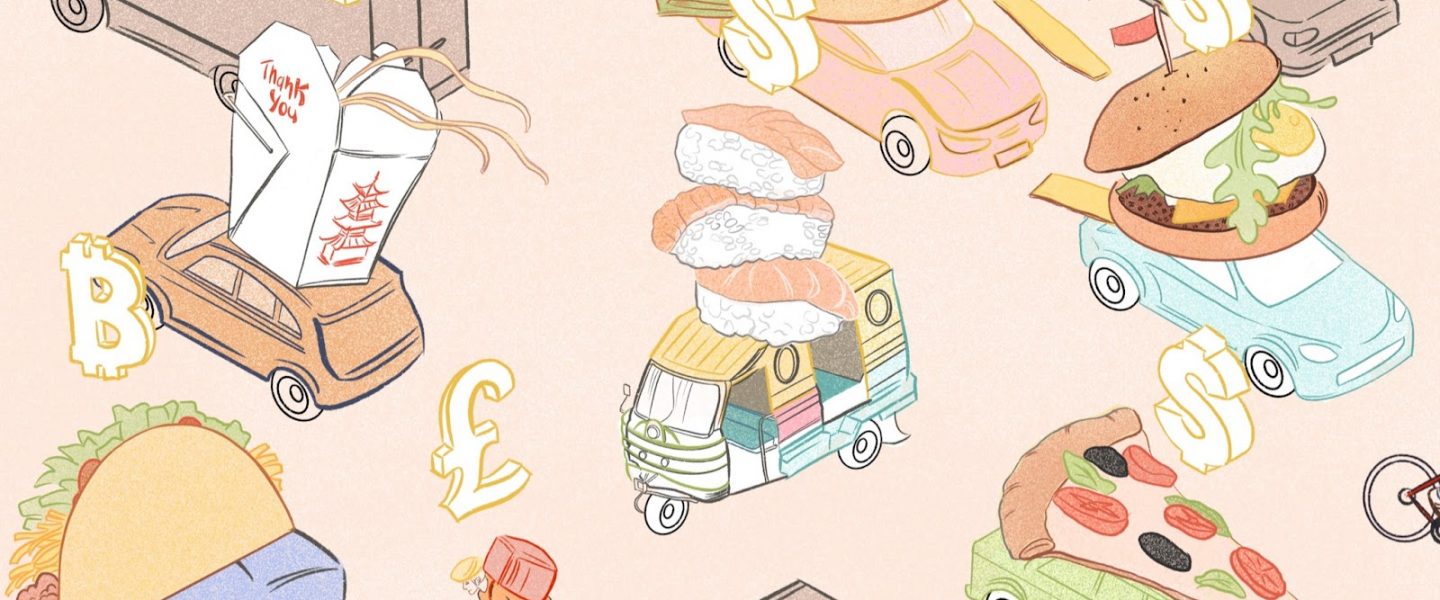Post-pandemic, restaurants’ survival remains a critical issue. Food delivery services may be their rescue — or their ruin.
The pandemic shuttered restaurants around the world, and many others switched to takeout and deliveries to survive. Food delivery services like Uber Eats, DoorDash, and Grubhub became household names in the US to the benefit of their bottom lines: Grubhub, which also owns Seamless, stated that the company generated 48 percent revenue growth in the US in the fourth quarter of 2020. The UK-based company Deliveroo became one of the fastest-growing startups in Europe in the last decade.
Yet Chicago restaurant The Bagel has a sign saying, “Support Local Businesses: Skip delivery apps — order directly!”
What’s the problem? According to The Bagel’s owner, Danny Wolf, “One of the contributing factors for businesses going out of business is high fees [charged by delivery services].” He led the Lakeview East Chamber of Commerce’s drive to put the signs in many restaurant windows to help local businesses avoid delivery costs that, according to Wolf, can be as high as 30 percent of an order’s value.
The signs are more relevant than ever. “Chicago recently passed an ordinance to put a cap on the amount of fees the delivery services can charge, but it has expired now,” Wolf said. “It is going back up again.”
The Bagel advertises via Grubhub but uses its own drivers for delivery. The national online delivery companies care only about their own profits, says Wolf. “They are interested in making money for themselves.”
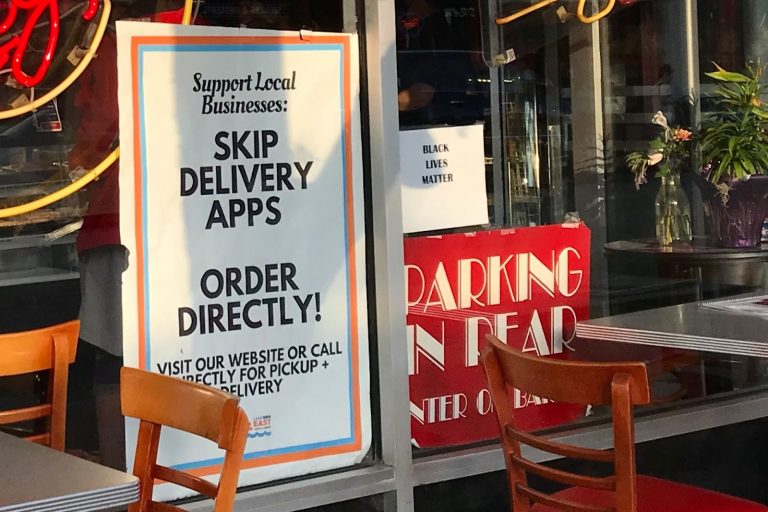
For four months, WhoWhatWhy has been tracking the effects of online food delivery services during the pandemic on restaurants and customers across the US, the UK, and Indonesia. Around the world, tens of thousands of restaurants have closed, and several million restaurant workers have lost their jobs since March 2020. In the US, more than 110,000 restaurants — 17 percent of all restaurants in the country — closed their doors, and owners of nearly three-quarters of those restaurants say they will not reopen. The National Restaurant Association estimates that the COVID-19 shutdowns cost the nation’s dining industry $290 billion in sales and the loss of 1.5 million jobs. In the UK, 8,560 restaurants have closed — 7.4 percent of the licensed restaurants there.
But despite what many restaurateurs claim is predatory pricing, those delivery services helped many restaurants to stay open even while their customers couldn’t enter the premises.
Now, however, as various countries cautiously reopen, what role will delivery services play in the future of restaurants? During the height of the pandemic, many restaurant owners felt delivery charges were too high but were unavoidable if they wanted to remain in business.
Since 1994, when Pizza Hut delivered the first online food order, the online delivery business has grown to encompass more than 6 percent of total restaurant sales and may reach 11 percent next year. In April 2021, 47 percent of US consumers ordered from an online delivery service, up from 38 percent in 2020, according to Bloomberg Second Measure. Postmates, Uber Eats, and DoorDash have more than quintupled sales since 2018.
Currently, DoorDash has 45 percent of the US market while globally, Uber Eats controls 29 percent of the food delivery market, according to Fortune, and has tripled its customer users and doubled its gross booking in 2020. Business of Apps also noted that Uber Eats grew by around 60 percent between 2019 and 2020.
During the height of the pandemic, profits rolled in for delivery service owners and investors as thousands of part-time drivers serviced restaurants.
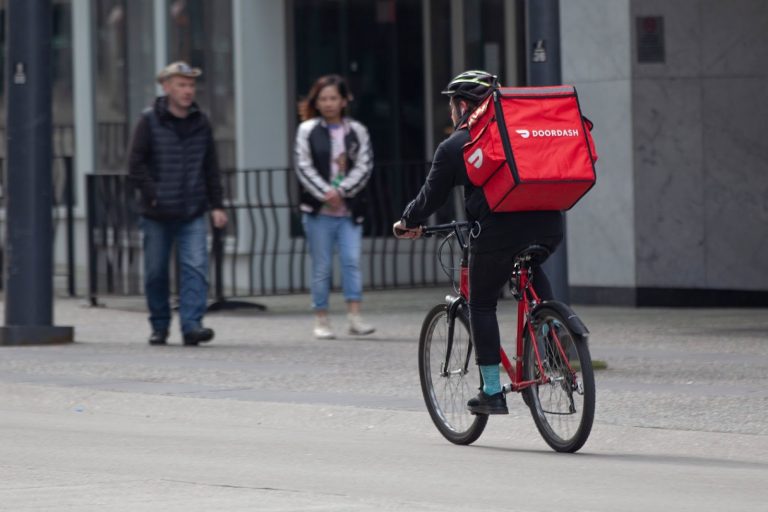
Excessive Delivery Fees?
“Quite often local restaurants explore the option of using delivery services, but decide not to go for it [due to the high fees],” Carol Gorley, executive director of Ohio’s Chamber of Commerce, told WhoWhatWhy.
A Chinese restaurant owner in Loveland, OH, told WhoWhatWhy that delivery services charge too high a percentage. The owner, who preferred to remain unnamed, fears that delivery service fees “could kill a business.” The restaurant delivers its own food to avoid delivery fees. “When I have a delivery order, I just call my wife and she picks it up and delivers,” the owner said.
In February, WhoWhatWhy spoke to Alex, the manager of El Picante restaurant in Cincinnati, OH, who preferred to use only his first name. The restaurant subscribed to Grubhub before the pandemic and remains in a partnership with them. Alex, though, feels the fees are exorbitant — El Picante receives only 60 percent of the revenue from the order.
When we checked with Alex in June, he said he believes the pandemic changed the way people eat out. While about 80 percent of their customers are dining in now, economic fallout from the pandemic has made customers cautious, and they’re spending less. “People are still scared of the virus,” Alex said. “I foresee people doing takeout more than dining in.”
For now, El Picante keeps the Grubhub subscription to help cover the overhead. “It is kind of expensive, but we are satisfied as it still brings about 10 percent of the full revenue,” Alex said.
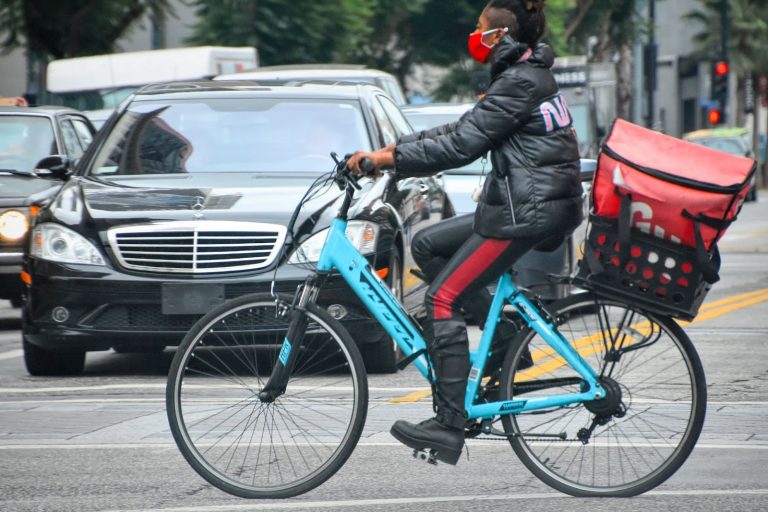
A Worldwide Challenge
Restaurants in the UK faced a similar problem. In June 2020, there were countless complaints that delivery services such as Deliveroo and Uber Eats were charging 30 percent delivery fees to small restaurants. “What was unfair was … their commission. We have been let down,” Ertugrul Elmas, of the Olives and Meze restaurant in London, told This is Money.
Like The Bagel in Chicago, some restaurants in London asked customers to order directly to help them avoid paying commission fees. Shefik Mehmet, chairman at the Harringay Traders’ Association, an organization representing 200 independent shops and restaurants in north London, believes that delivery services “have been very greedy with these charges” and urged them to bring the prices down.
Despite the high fees, some local restaurants in Manchester have needed delivery services to survive. Marcus Wright, director of Wright’s Fish and Chip Shop, partnered with Deliveroo in December 2020, which charges a 30 percent delivery fee per order. Wright raised his prices by 20 percent to cover the cost. He says delivery now comprises 20 percent of his business; the rest is from takeout. “In the current climate, it’s helpful,” Wright told WhoWhatWhy. “Obviously, it’s the pandemic that’s harmful, not the delivery service.”
Damian Miles, the owner of Herbivorous Manchester, a local vegan restaurant, also partnered with Deliveroo and Uber Eats, which charge 30 percent per order; the restaurant raised prices by 20 and 30 percent respectively. Miles said other delivery services offer cheaper fees, but he finds them unreliable. “I do wish it was cheaper, but I understand,” Miles said.
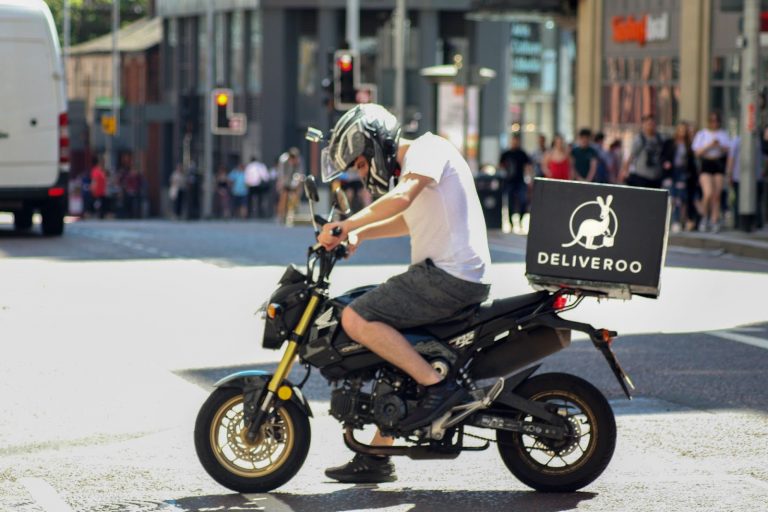
Widening the Customer Base
One benefit of delivery services is the new opportunities. According to Miles, using online delivery allows him to reach customers from different and wider geographical locations. “We can reach a much wider audience — we’re hitting a bigger market,” he said. During the lockdown, delivery services accounted for 75 percent of his business, up from the 40 percent he saw before the pandemic. “There’s obviously been an increase [in the use of delivery services] since the start of lockdown,” Miles explained. “It’s not ideal. … But they’ve been helpful,” Miles continued.
Some restaurant employees in Indonesia agree with Miles. “I don’t find [delivery services] harmful — for me, it’s helpful,” said Yani, a supervisor at a local seafood restaurant in Jakarta, who spoke on the condition of anonymity because her boss didn’t want her speaking to the media.
The restaurant uses its own delivery services for up to a 1.2 mile radius; for anything farther, the restaurant recommends Grab Food, one of the largest delivery platforms in Indonesia. Delivery accounts for about 60 percent of the restaurant’s revenue; Grab Foods delivers 30 percent of that, and the restaurant delivers the other 70 percent.
“I would say that Grab Food is useful,” Yani said. “If we cannot have cash flow [from] dine-in [customers], Grab Food could help us with our sales,” especially, she added, because the restaurants received no financial support from the government. Yani told WhoWhatWhy that regular customers who are located far from the restaurant use Grab Food, allowing them to keep their loyal customers.
According to Yani, Grab Food charges a 20 percent service fee; the restaurant also increased the price of its meals delivered by Grab Food by that amount.
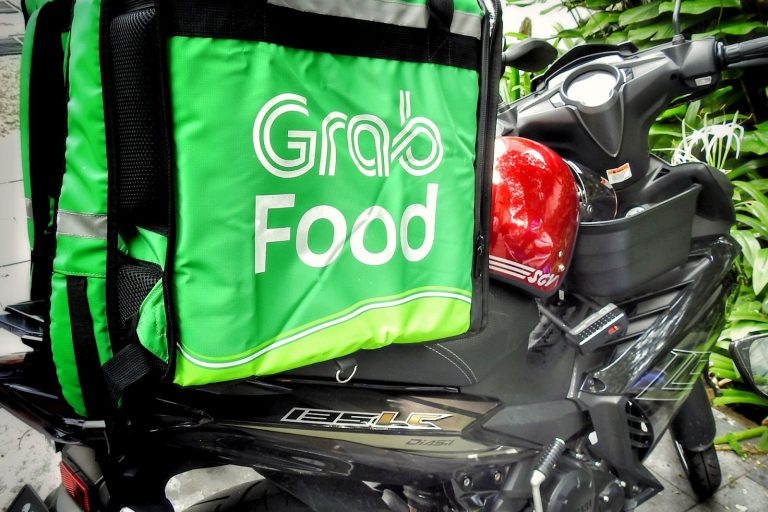
The Uncertainty of Government Aid
Restaurants are using outdoor spaces, particularly in urban settings, to maintain capacity and minimize dependence on delivery apps. During the winter of 2021, deSha’s American Tavern in Cincinnati converted part of its parking lot into a patio with tables. With money from the Paycheck Protection Plan, they created an isolated glass igloo dining structure heated by a fireplace. The general manager of deSha’s, Don Arnold, told WhoWhatWhy in June that the igloos, unused during the summer, were so popular that they hope to reopen them when the weather gets cold.
To help restaurants keep their doors open, Congress introduced a bipartisan bill in June to add another $60 billion to the Restaurant Revitalization Fund — double its original allocation.
In the UK, the British government planned its restaurant furlough protection schemes to end in April 2021, but this was extended to September 30 — the government will pay 70 percent of workers’ salaries, and employers will pay 10 percent for hours not worked. From August to September, the government will pay 60 percent and employers 20 percent, the BBC reported. The UK also extended the hospitality & tourism VAT cut to 5 percent until September 30 ; then 12.5 percent until April 30, 2022 (it was 20 percent pre-pandemic).
Tony Sophoclides, strategic affairs director for the restaurant trade group UK Hospitality, said, “Should there be another spike in COVID-19 cases, then government support will be vital for survival.” Before COVID-19, delivery services “appeared to have very little impact on eating out, while during lockdowns they helped to keep some businesses afloat,” says Sophoclides. “Both have the capacity to coexist in what we hope will be a hospitality-led recovery for Britain.”
Government Restrictions
In some cities and states, high food delivery charges are sparking political opposition and legislative restrictions. Some major cities like Berkeley, CA, have limited service fees that third-party food delivery apps can charge. This means services like Uber Eats, Postmates, DoorDash, Caviar, and Grubhub will be limited to charging no more than 15 percent for delivery fees and up to 5 percent for other service fees. On June 22, San Francisco approved a permanent 15 percent cap on delivery fees for third-party apps.
The National Restaurant Association has sent several letters to the US Conference of Mayors and the National Governors Association asking state and local governments to take action against third-party delivery companies by capping delivery and service fees and preventing hidden fees.
Both Deliveroo and Uber Eats UK defend their commission fee structures, with Uber Eats insisting that reducing commission fees will make its platform unreliable and unsafe for all parties. They explain that commissions paid by restaurants help cover background checks for new drivers, fair earnings for drivers, restaurant advertisements, and more secure payment systems.
Deliveroo claims that its fees provide support for small restaurants and pay rider fees. Deliveroo explained that its commission reflects the range of services provided, including customer support, marketing and invoicing, and sales reporting to restaurants.
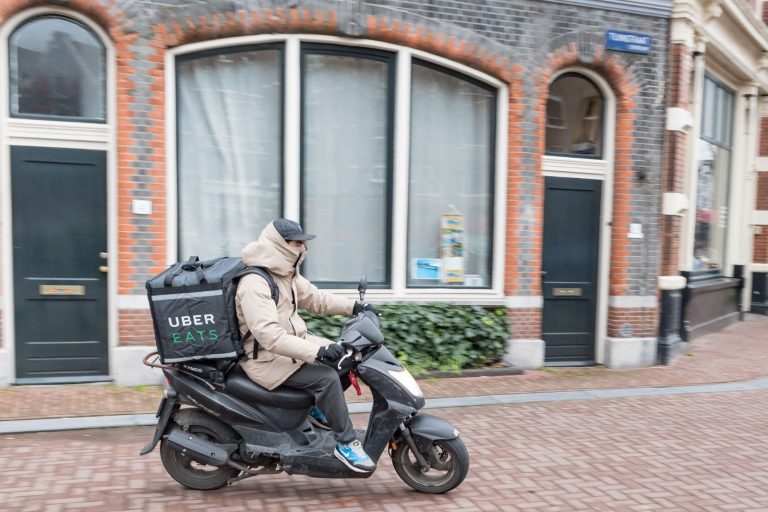
Bigger. Pricier. Nastier.
As food delivery continues to grow, will their business models become more equitable? Not necessarily: UK’s Deliveroo opened on the London Stock Exchange at $10.4 billion (£7.6 billion), lower than expected, but still potentially netting its CEO over $500 million (£360 million) while Deliveroo’s drivers average less than minimum wage (£8.20 an hour, roughly $11.39), with some making as little as $2.75 (£2) per hour, according to an investigative report by The Mirror, the Bureau of Investigative Journalism, and ITV News. According to Business of Apps, in 2018, Deliveroo’s revenue grew from $661 million to nearly $1.7 billion in 2020.
Food delivery apps are also getting more expensive to use; customers pay an average of 23 percent more on apps than when they order directly, according to the BBC. In the UK, orders from Deliveroo cost an average of 31 percent more than ordering directly from the restaurants. Uber Eats UK costs an extra 25 percent, and Just Eat an extra 7 percent. In the US, a Subway sandwich that Uber Eats delivers will be up to 91 percent more expensive than if it’s ordered from the store. Grubhub is 17 percent more expensive, followed by Uber Eats at 29.7 percent, DoorDash at 32.8 percent, and Postmates at 40.5 percent.
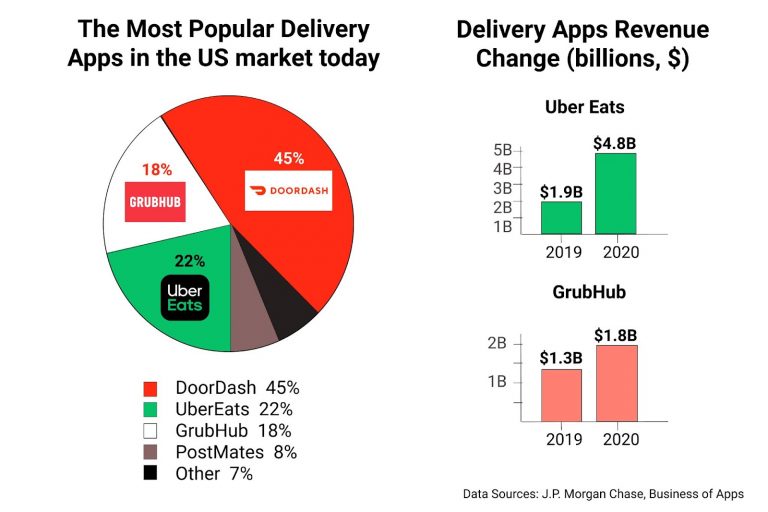
The stakes for market share are so high that delivery services in 2020 spent nearly $300 million on ads. Uber Eats and Grubhub each budgeted more than $100 million on celebrity-studded advertising in the US alone, according to Media Radar and AW 360. COMvergence, an independent research company, estimated Deliveroo’s 2019 global media spending to be around $30 million; $12 million of that was spent in the UK.
Independent restaurant owners face a conundrum: Are delivery services their friends or their enemies? Independent restaurants depend on delivery platforms for survival, but as businesses reopen, that need may diminish. In the meantime, many restaurateurs feel powerless to negotiate for better delivery fee deals or for more government help. For now, restaurants are coping by raising the prices of their meals.
Delivery services, however, will need to cope with the significant decline in business as restaurants see a surge in in-person dining during the summer. The delivery services claim they are trying to help local restaurants, yet some have teamed up with major restaurant chains that compete with independent operators. Last year, DoorDash penned deals with Little Caesars, Wendy’s, Chick-fil-A, and McDonald’s, all of which also offer delivery with Uber Eats.
According to Kate Conger, a tech reporter for The New York Times, many people found delivery apps useful during the pandemic and are willing to use them even when it costs more. So it begs the question: Will delivery services be more dominant than ever after the pandemic? Probably. A DoorDash executive said in an interview that it’s hard for people to backpedal from the things they have found convenient. Some restaurants are learning to coexist with delivery services, while others try to find a way around them.
The plea found in those Chicago restaurant windows may be the gospel that independent restaurants must preach if they want to survive: “Skip delivery apps — order directly!”
